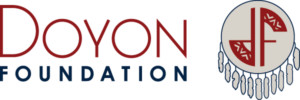Supported by Doyon Foundation, Diiginjik K’yaa Ch’at’oh (“Our Language Nest”) is an immersion program that teaches children to become fluent speakers of Gwich’in while helping preserve one of the world’s most threatened Indigenous languages.
Diiginjik K’yaa Ch’at’oh meets Saturdays at various sites in and around Fairbanks so that parents and children may speak Gwich’in, sing songs, share lessons and create learning activities. Virtually all activities are in Gwich’in, and the activity is free of charge.
“The group is open to everyone, but especially parents with young children,” says Allan Hayton, the Foundation’s language revitalization program director. “The goal is to teach Gwich’in to children by talking to them in the language.”
Gatherings typically attract a half-dozen or so parents and as many as 10 children. There is no fee to attend and parents also rely on the group to learn Gwich’in.
A “no-English” policy is typical of language nest immersion programs in Alaska and throughout the world. Adopting the metaphor of a nest as a safe place to learn, Diiginjik K’yaa Ch’at’oh is an early childhood education project that brings together Elders who are fluent speakers and parents and children, who typically speak English only.
Hayton began working with parents in 2015 to start Diiginjik K’yaa Ch’at’oh; today he’s among the group’s leaders, which includes parents and other community members. Partners include University of Alaska Fairbanks (UAF) Rural Student Services and Denakkanaaga, the Fairbanks-based nonprofit organization for Native Elders. Over the years, the group has met outdoors, at parents’ homes, at Denakkanaaga and the UAF campus.
“No two Language Nest meetings are the same,” says Charlene Stern, a mother who has been involved since the group’s very first meeting. By the time her son was born, Charlene says she realized she wanted him to hear Gwich’in daily, at home. Charlene’s first language is English; her mother and siblings are fluent Gwich’in speakers.
Diiginjik K’yaa Ch’at’oh differs from teaching that introduces vocabulary in a new language by having students memorize isolated words or phrases. Some meetings involve getting together to share a meal and practice Gwich’in table phrases. Other gatherings focus on games and songs or venturing outdoors. This in-context approach teaches Gwich’in by offering everyday, appealing situations that “feed” the language into ears of young children. Two primary teachers who are fluent speakers are on hand at Diiginjik K’yaa Ch’at’oh gatherings. Parents who are second-language learners also are welcome to lead activities and lessons.
Worldwide language nest projects trace their start to 1982 and successful efforts to revive the Maori language in New Zealand. In Alaska, the nine ancestral languages of the Doyon region were the first languages spoken by the people as recently as 100 years ago. Revitalization programs like Diiginjik K’yaa Ch’at’oh can add to the number of fluent speakers and lessen the risk that the language will be lost.
“For me, one of the most important things about the Language Nest is that it creates a space where our children positively engage with our culture and language,” Charlene says. Alaska Native children typically are a minority in urban public schools, and she says Native children often experience discrimination that fosters feelings of inferiority. “Language Nest helps equip our children with stronger identities so that they become more resilient individuals and tribal members.”
Language nests such as Diiginjik K’yaa Ch’at’oh adhere to evidence-based strategies in early childhood education. For instance, research shows that up to about age 7, children acquire a second language – or third or fourth – as naturally as they learn a first language.
Diiginjik K’yaa Ch’at’oh is one of several Foundation-supported programs to revitalize Indigenous languages in the Doyon region. Efforts include the Native Word of the Month and Doyon Languages Online, the grant-funded project that is developing online lessons for five of the Doyon languages: Holikachuk, Denaakk’e, Benhti Kenaga’, Hän and Dinjii Zhuh K’yaa. Plans eventually call for online lessons in all Doyon region languages.
Charlene is among the Diiginjik K’yaa Ch’at’oh parents from families who encouraged English as a step to success in the Western world. “Today we know that speaking more than one language carries many benefits,” she says. “And we know that culture and language revitalization is critical to personal identity and collective well-being.”
She’s looking forward to a time when more families take part in Diiginjik K’yaa Ch’at’oh or similar community-driven efforts.
“We participate because it’s something that’s important to us, our children, and generations yet to come,” she says. “We can’t look to organizations, school districts or government grants to singlehandedly revitalize the Gwich’in language. I believe it’s up to us.”
For more information on Diiginjik K’yaa Ch’at’oh and how to get involved in the Language Nest, please contact Allan Hayton at 907.459.2162 or haytona@doyon.com.
